Debris Flow Prediction Based on the Fast Multiple Principal Component Extraction and Optimized Broad Learning
Abstract
1. Introduction
2. Overview of the Study Area
2.1. Topography and Geomorphology
2.2. Distribution and Law of Debris Flow
3. Theories and Method
3.1. FMPCE
3.2. Broad Learning
3.2.1. Initial Structure
3.2.2. Updated Structure
3.3. Improved Broad Learning
4. Modeling Process and Result Analysis
4.1. Establishment of Debris Flow Probability Prediction Model
| Algorithm 1 Debris flow prediction based on the SVDBL algorithm |
| Input: Training sample and actual input Output: Debris flow probability |
| 1 for do 2 Initialize and 3 Calculate 4 Calculate by SVD 5 end 6 for do 7 Initialize and 8 Calculate 9 Calculate by SVD 10 end 11 Let 12 Calculate by Equation (8) 13 while the training accuracy does not meet the requirements do 14 Initialize and 15 Calculate ; Update 16 Calculate by SVD 17 Update 18 Calculate and by Equations (22) and (23) 19 20 end 21 Calculate by SVD 22 Calculate 23 Calculate and by Equation (8) 24 Let 25 Calculation of debris flow probability |
4.2. Determine the Influencing Factors and Data Sources
4.3. Data Preprocessing
- (1)
- Missing value processing
- (2)
- Outlier processing
- (3)
- Normalization
4.4. Evaluating Indicator
- (1)
- Root mean square error
- (2)
- Mean absolute percentage errorwhere the is the actual value and is the predicted value of the model.
- (3)
- coefficient of determination R2where the SSR is the sum of squares of regression, and SST is the sum of squares of total deviation.
- (4)
- AUCwhere the M is the number of positive samples, N is the number of negative samples and is the ith sample serial number.
4.5. Simulation Verification and the Result Analysis
5. Conclusions
Author Contributions
Funding
Data Availability Statement
Acknowledgments
Conflicts of Interest
References
- Reid, M.E.; Coe, J.A.; Brien, D.L. Forecasting Inundation from Debris Flows That Grow Volumetrically during Travel, with Application to the Oregon Coast Range, USA. Geomorphology 2016, 273, 396–411. [Google Scholar] [CrossRef]
- Li, L.; Cheng, S.; Wen, Z. Landslide Prediction Based on Improved Principal Component Analysis and Mixed Kernel Function Least Squares Support Vector Regression Model. J. Mt. Sci. 2021, 18, 2130–2142. [Google Scholar] [CrossRef]
- Kim, H.-S.; Chung, C.-K.; Kim, S.-R.; Kim, K.-S. A GIS-Based Framework for Real-Time Debris-Flow Hazard Assessment for Expressways in Korea. Int. J. Disaster Risk Sci. 2016, 7, 293–311. [Google Scholar] [CrossRef]
- Zahiri, A.; Najafzadeh, M. Optimized Expressions to Evaluate the Flow Discharge in Main Channels and Floodplains Using Evolutionary Computing and Model Classification. Int. J. River Basin Manag. 2018, 16, 123–132. [Google Scholar] [CrossRef]
- Gong, X.-L.; Chen, X.-Q.; Chen, K.-T.; Zhao, W.-Y.; Chen, J.-G. Engineering Planning Method and Control Modes for Debris Flow Disasters in Scenic Areas. Front. Earth Sci. 2021, 9, 712403. [Google Scholar] [CrossRef]
- Zhu, X.H.; Zhuang, J.Q.; Liu, T.M.; Tong, X.; Ma, P.H. Developmental characteristics and hazard analysis of debris flow in Jiaochang Gully of Huxian County, Xi’an City. J. Nat. Disasters 2016, 25, 27–33. [Google Scholar] [CrossRef]
- Tiwari, B.; Ajmera, B.; Gonzalez, A.; Sonbol, H. Impact of Wildfire on Triggering Mudslides—A Case Study of 2018 Montecito Debris Flows. In Proceedings of the Geo-Congress 2020: Engineering, Monitoring, and Management of Geotechnical Infrastructure, Minneapolis, MN, USA, 25–28 February 2020; American Society of Civil Engineers (ASCE): Reston, VA, USA, 2020; pp. 40–49. [Google Scholar]
- Zhang, H.; Liu, X.; Cai, E.; Huang, G.; Ding, C. Integration of Dynamic Rainfall Data with Environmental Factors to Forecast Debris Flow Using an Improved GMDH Model. Comput. Geosci. 2013, 56, 23–31. [Google Scholar] [CrossRef]
- Pudasaini, S.P.; Fischer, J.-T. A Mechanical Model for Phase Separation in Debris Flow. Int. J. Multiph. Flow 2020, 129, 103292. [Google Scholar] [CrossRef]
- Xu, W.; Yu, W.; Zhang, G. Prediction Method of Debris Flow by Logistic Model with Two Types of Rainfall: A Case Study in the Sichuan, China. Nat. Hazards 2012, 62, 733–744. [Google Scholar] [CrossRef]
- Kim, S.D.; Jeung, S.J.; Kim, B.S. Prediction of Debris Flows in the Korean Oship River Based on Climate Change Scenarios. Geomat. Nat. Hazards Risk 2018, 9, 703–719. [Google Scholar] [CrossRef]
- Lombardo, L.; Bachofer, F.; Cama, M.; Märker, M.; Rotigliano, E. Exploiting Maximum Entropy Method and ASTER Data for Assessing Debris Flow and Debris Slide Susceptibility for the Giampilieri Catchment (North-Eastern Sicily, Italy). Earth Surf. Process. Landf. 2016, 41, 1776–1789. [Google Scholar] [CrossRef]
- Najafzadeh, M. Neuro-Fuzzy GMDH Systems Based Evolutionary Algorithms to Predict Scour Pile Groups in Clear Water Conditions. Ocean. Eng. 2015, 99, 85–94. [Google Scholar] [CrossRef]
- Di, B.; Zhang, H.; Liu, Y.; Li, J.; Chen, N.; Stamatopoulos, C.A.; Luo, Y.; Zhan, Y. Assessing Susceptibility of Debris Flow in Southwest China Using Gradient Boosting Machine. Sci. Rep. 2019, 9, 12532. [Google Scholar] [CrossRef]
- Pandey, V.K.; Sharma, K.K.; Pourghasemi, H.R.; Bandooni, S.K. Sedimentological Characteristics and Application of Machine Learning Techniques for Landslide Susceptibility Modelling along the Highway Corridor Nahan to Rajgarh (Himachal Pradesh), India. CATENA 2019, 182, 104150. [Google Scholar] [CrossRef]
- Zhang, S.H.; Wu, G. Debris Flow Susceptibility and Its Reliability Based on Random Forest and GIS. Sci. J. Earth Sci. 2019, 44, 3115–3134. [Google Scholar] [CrossRef]
- Nikolopoulos, E.I.; Destro, E.; Bhuiyan, M.A.E.; Borga, M.; Anagnostou, E.N. Evaluation of Predictive Models for Post-Fire Debris Flow Occurrence in the Western United States. Nat. Hazards Earth Syst. Sci. 2018, 18, 2331–2343. [Google Scholar] [CrossRef]
- Liu, D.L.; Zhang, S.J.; Yang, H.J. Design and implementation of debris-flow forecast system based on water-soil coupling mechanism. Comput. Eng. Des. 2014, 35, 3667–3673. [Google Scholar] [CrossRef]
- Geng, J.D.; Chen, W.Y.; Zhao, Y.H. A Precise Prediction Model on Debris Flows Caused by Runoff Mechanism Based on Channel Width and Particle Size. China Earthq. Eng. J. 2021, 43, 983–988. [Google Scholar]
- Banihabib, M.E.; Tanhapour, M. An Empirical Equation to Determine the Threshold for Rainfall-Induced Landslides Developing to Debris Flows. Landslides 2020, 17, 2055–2065. [Google Scholar] [CrossRef]
- Wei, Z.L.; Sun, H.Y.; Pan, P.; Shang, Y.Q. Forecast for average velocity of debris flow based on MLS method. J. Nat. Disasters 2016, 25, 56–61. [Google Scholar] [CrossRef]
- Imaizumi, F.; Masui, T.; Yokota, Y.; Tsunetaka, H.; Hayakawa, Y.S.; Hotta, N. Initiation and Runout Characteristics of Debris Flow Surges in Ohya Landslide Scar, Japan. Geomorphology 2019, 339, 58–69. [Google Scholar] [CrossRef]
- Vergara Dal Pont, I.P.; Santibañez Ossa, F.A.; Araneo, D.; Ferrando Acuña, F.J.; Moreiras, S.M. Determination of Probabilities for the Generation of High-Discharge Flows in the Middle Basin of Elqui River, Chile. Nat. Hazards 2018, 93, 531–546. [Google Scholar] [CrossRef]
- Giannecchini, R.; Galanti, Y.; D’Amato Avanzi, G.; Barsanti, M. Probabilistic Rainfall Thresholds for Triggering Debris Flows in a Human-Modified Landscape. Geomorphology 2016, 257, 94–107. [Google Scholar] [CrossRef]
- Meng, F.Q.; Li, G.J.; Wang, Q.B.; Qing, S.W.; Zhao, H.Q.; Jin, X. Research on early warning of debris flow based on efficacy coefficient method. Rock Soil Mech. 2012, 33, 835–840. [Google Scholar] [CrossRef]
- Zhang, S.; Yang, H.; Wei, F.; Jiang, Y.; Liu, D. A Model of Debris Flow Forecast Based on the Water-Soil Coupling Mechanism. J. Earth Sci. 2014, 25, 757–763. [Google Scholar] [CrossRef]
- Liang, W.Z.; Zhao, G.Y. Comprehensive prediction of mine debris flow’risk based on weight-varying cloud model. Chin. J. Geol. Hazard Control. 2017, 28, 82–88. [Google Scholar] [CrossRef]
- Qiao, S.; Qin, S.; Chen, J.; Hu, X.; Ma, Z. The Application of a Three-Dimensional Deterministic Model in the Study of Debris Flow Prediction Based on the Rainfall-Unstable Soil Coupling Mechanism. Processes 2019, 7, 99. [Google Scholar] [CrossRef]
- Banihabib, M.E.; Tanhapour, M.; Roozbahani, A. Bayesian Networks Model for Identification of the Effective Variables in the Forecasting of Debris Flows Occurrence. Environ. Earth Sci. 2020, 79, 179. [Google Scholar] [CrossRef]
- Wu, M.-H.; Wang, J.P.; Chen, I.-C. Optimization Approach for Determining Rainfall Duration-Intensity Thresholds for Debris Flow Forecasting. Bull. Eng. Geol. Environ. 2019, 78, 2495–2501. [Google Scholar] [CrossRef]
- Kern, A.N.; Addison, P.; Oommen, T.; Salazar, S.E.; Coffman, R.A. Machine Learning Based Predictive Modeling of Debris Flow Probability Following Wildfire in the Intermountain Western United States. Math. Geosci. 2017, 49, 717–735. [Google Scholar] [CrossRef]
- Xiao, L.; Zhang, Y.; Ge, T.; Wang, C.; Wei, M. Analysis, Assessment and Early Warning of Mudflow Disasters along the Shigatse Section of the China–Nepal Highway. Open Geosci. 2020, 12, 44–58. [Google Scholar] [CrossRef]
- Su, T.-J.; Pan, T.-S.; Chang, Y.-L.; Lin, S.-S.; Hao, M.-J. A Hybrid Fuzzy and K-Nearest Neighbor Approach for Debris Flow Disaster Prevention. IEEE Access 2022, 10, 21787–21797. [Google Scholar] [CrossRef]
- Hirschberg, J.; Badoux, A.; McArdell, B.W.; Leonarduzzi, E.; Molnar, P. Evaluating Methods for Debris-Flow Prediction Based on Rainfall in an Alpine Catchment. Nat. Hazards Earth Syst. Sci. 2021, 21, 2773–2789. [Google Scholar] [CrossRef]
- Wang, X.; Wang, C.; Zhang, C. Early Warning of Debris Flow Using Optimized Self-Organizing Feature Mapping Network. Water Supply 2020, 20, 2455–2470. [Google Scholar] [CrossRef]
- Cao, C.; Song, S.; Chen, J.; Zheng, L.; Kong, Y. An Approach to Predict Debris Flow Average Velocity. Water 2017, 9, 205. [Google Scholar] [CrossRef]
- Zhang, Y.; Wu, K.L.; Deng, X.Q.; Wang, W. Prediction model of Jiangjiagou debris flow average velocity based on relevance vector machine. J. Nat. Disasters 2019, 28, 146–153. [Google Scholar] [CrossRef]
- Lee, D.-H.; Cheon, E.; Lim, H.-H.; Choi, S.-K.; Kim, Y.-T.; Lee, S.-R. An Artificial Neural Network Model to Predict Debris-Flow Volumes Caused by Extreme Rainfall in the Central Region of South Korea. Eng. Geol. 2021, 281, 105979. [Google Scholar] [CrossRef]
- Mei, Y.; Hong, F.; Jia, Z.; Kang, Z. Debris Flow Forecasting of Northwest of Yunnan Province Based on LR, SVM, and RF Statistical Models. In Proceedings of the 2018 26th International Conference on Geoinformatics, Kunming, China, 28–30 June 2018; pp. 1–7. [Google Scholar]
- Hu, Y.H.; Yuan, L.; Ma, D.T.; Li, M. Research Progress on Debris Flow Infrasound Warning. Adv. Earth Sci. 2018, 33, 606–613. [Google Scholar]
- Li, Y.; Chen, W.; Rezaie, F.; Rahmati, O.; Davoudi Moghaddam, D.; Tiefenbacher, J.; Panahi, M.; Lee, M.-J.; Kulakowski, D.; Tien Bui, D.; et al. Debris Flows Modeling Using Geo-Environmental Factors: Developing Hybridized Deep-Learning Algorithms. Geocarto Int. 2022, 37, 5150–5173. [Google Scholar] [CrossRef]
- Min, Y.; Hu, J.; Li, C.; Xu, Y.J.; Li, H.; Li, X.; Wan, S.; Li, L.; Yang, S.Y. Prediction Model about Landslide and Debris Flow in Yunnan Province. J. Catastrophol. 2013, 28, 216–220. [Google Scholar]
- Kean, J.W.; Staley, D.M. Forecasting the Frequency and Magnitude of Postfire Debris Flows Across Southern California. Earth Future 2021, 9, e2020EF001735. [Google Scholar] [CrossRef]
- Kong, L.Z.; Gao, Y.B.; Li, H.; Zhang, H.P. A Fast Algorithm That Extracts Multiple Principle Components in Parallel. Acta Autom. Sin. 2017, 43, 835–842. [Google Scholar] [CrossRef]
- Chen, C.L.P.; Liu, Z. Broad Learning System: An Effective and Efficient Incremental Learning System Without the Need for Deep Architecture. IEEE Trans. Neural Netw. Learn. Syst. 2018, 29, 10–24. [Google Scholar] [CrossRef] [PubMed]
- Xu, A.-B.; Xie, D. Low-Rank Approximation Pursuit for Matrix Completion. Mech. Syst. Signal Processing 2017, 95, 77–89. [Google Scholar] [CrossRef]
- Marra, F.; Nikolopoulos, E.I.; Creutin, J.D.; Borga, M. Space–Time Organization of Debris Flows-Triggering Rainfall and Its Effect on the Identification of the Rainfall Threshold Relationship. J. Hydrol. 2016, 541, 246–255. [Google Scholar] [CrossRef]
- Mostbauer, K.; Kaitna, R.; Prenner, D.; Hrachowitz, M. The Temporally Varying Roles of Rainfall, Snowmelt and Soil Moisture for Debris Flow Initiation in a Snow-Dominated System. Hydrol. Earth Syst. Sci. 2018, 22, 3493–3513. [Google Scholar] [CrossRef]
- Tayyebi, S.M.; Pastor, M.; Stickle, M.M. Two-Phase SPH Numerical Study of Pore-Water Pressure Effect on Debris Flows Mobility: Yu Tung Debris Flow. Comput. Geotech. 2021, 132, 103973. [Google Scholar] [CrossRef]
- Morino, C.; Conway, S.J.; Balme, M.R.; Hillier, J.; Jordan, C.; Sæmundsson, Þ.; Argles, T. Debris-Flow Release Processes Investigated through the Analysis of Multi-Temporal LiDAR Datasets in North-Western Iceland: Debris-Flow Processes Investigated by Multi-Temporal LiDAR Datasets. Earth Surf. Process. Landf. 2019, 44, 144–159. [Google Scholar] [CrossRef]
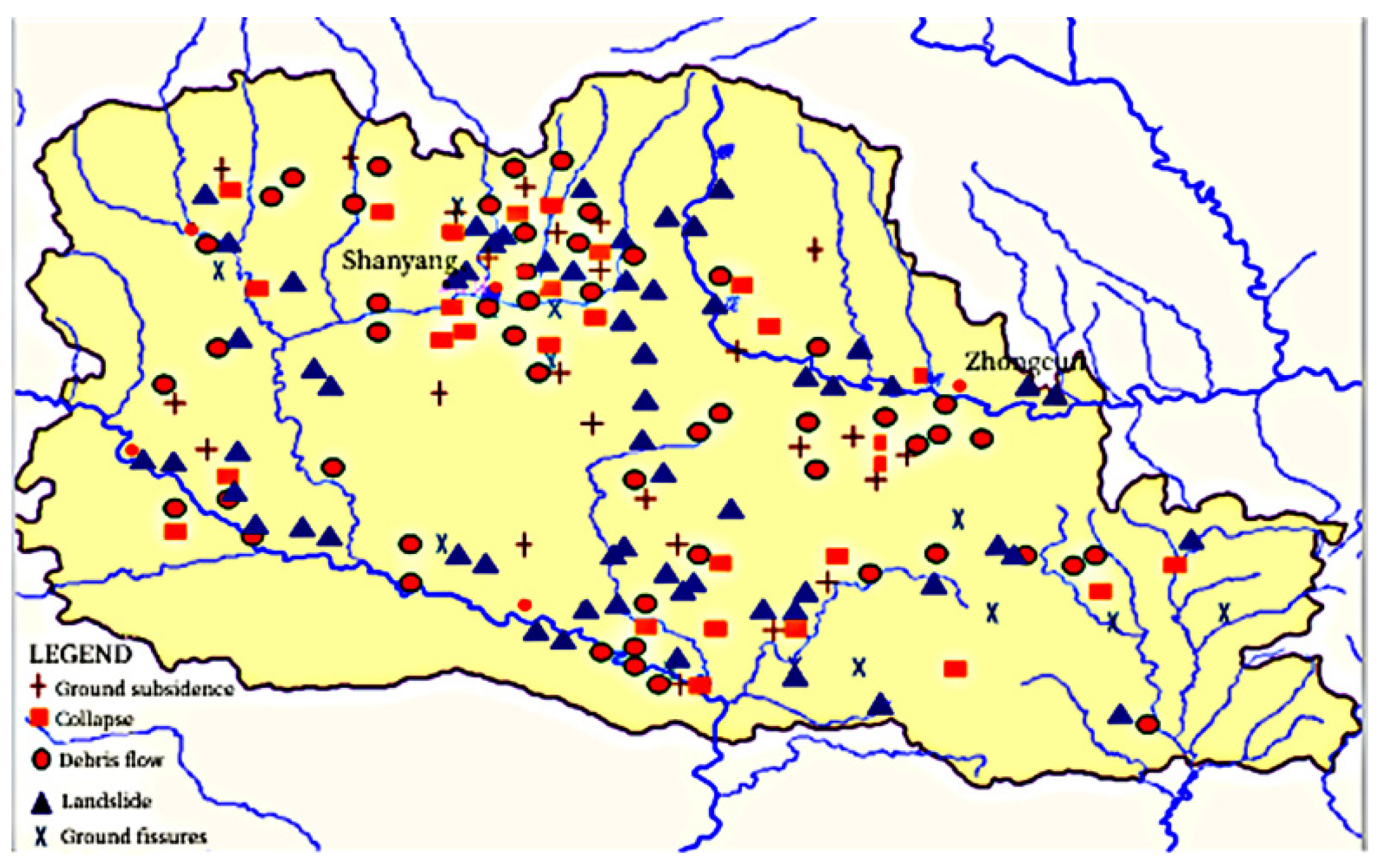
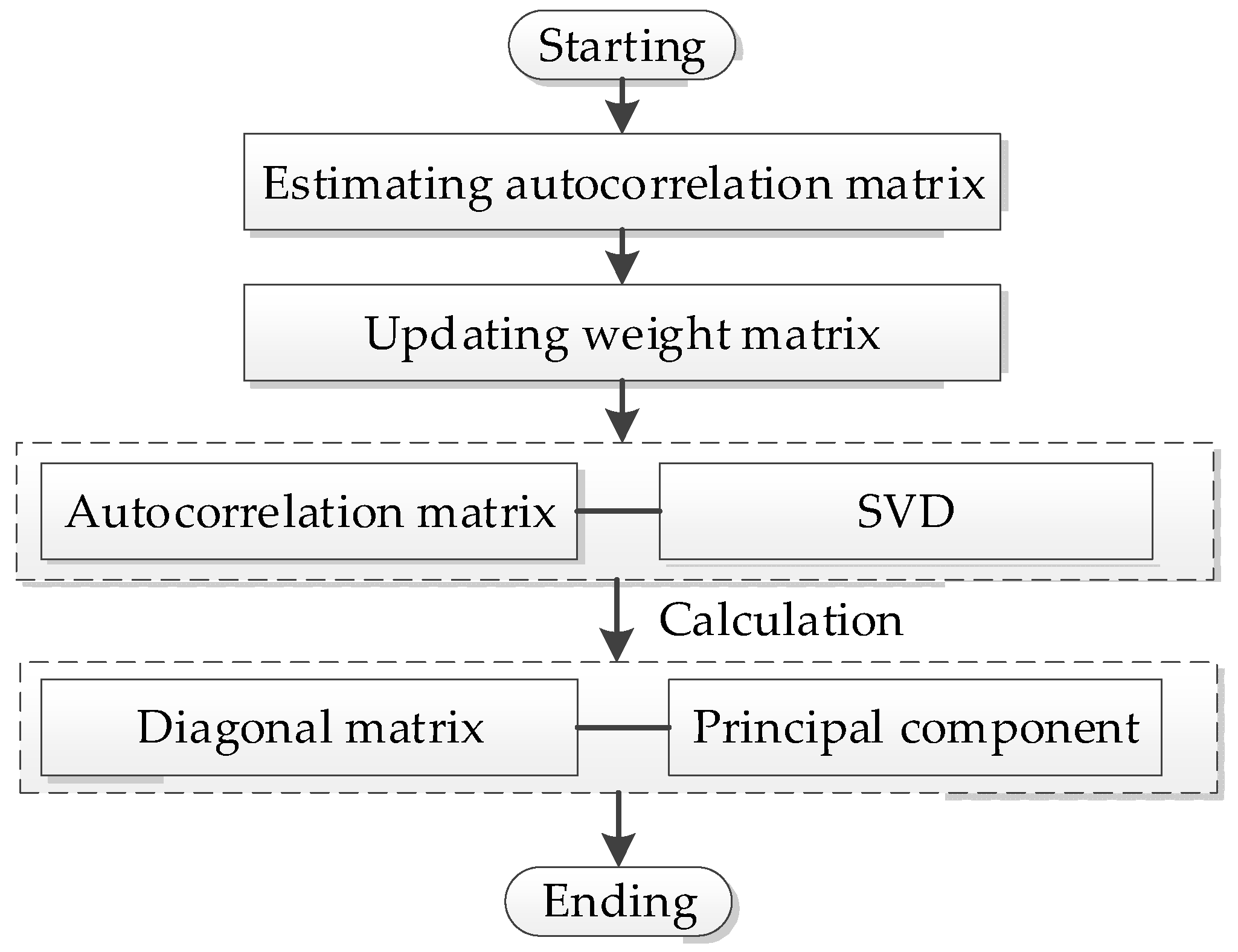
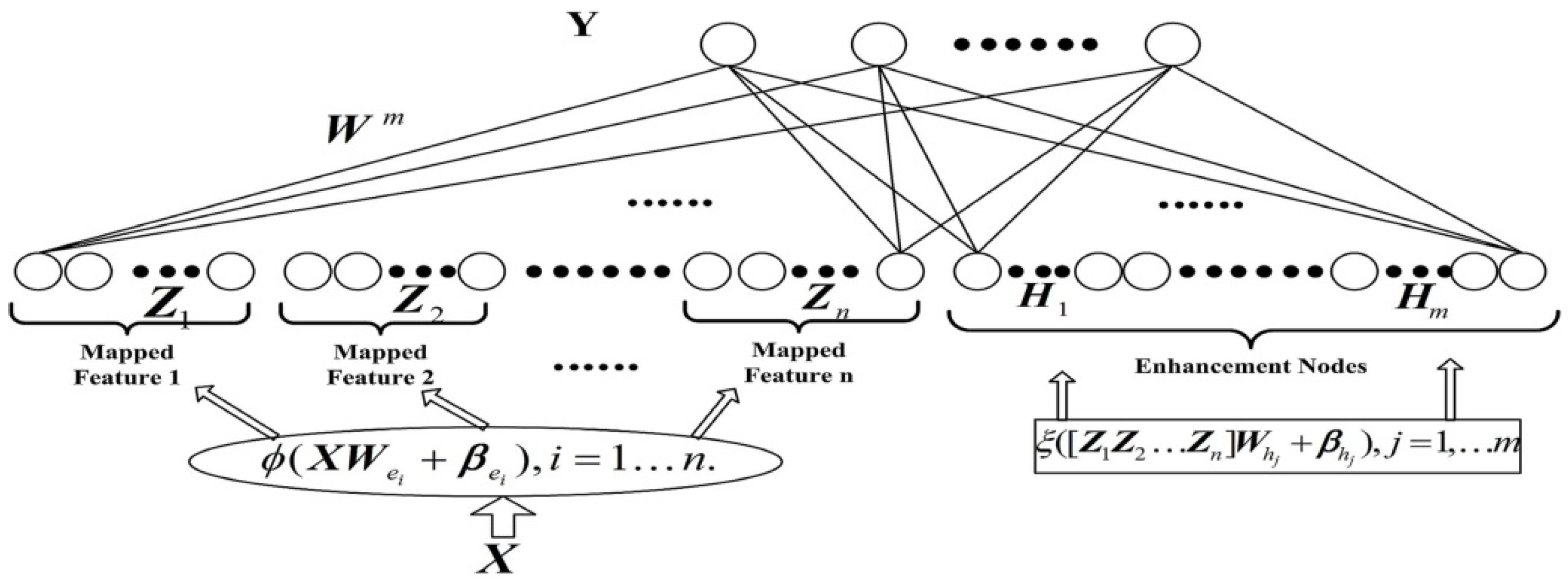

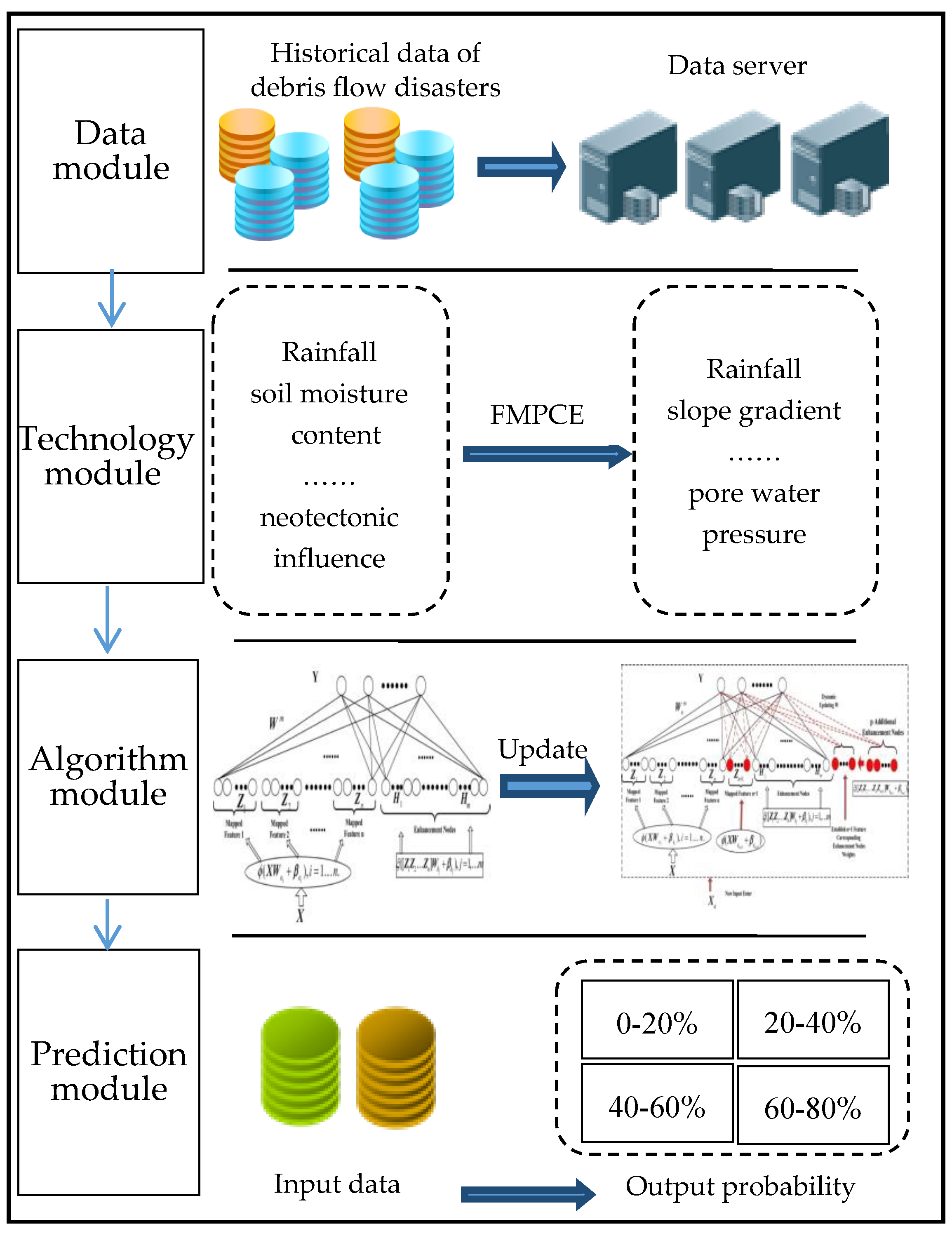

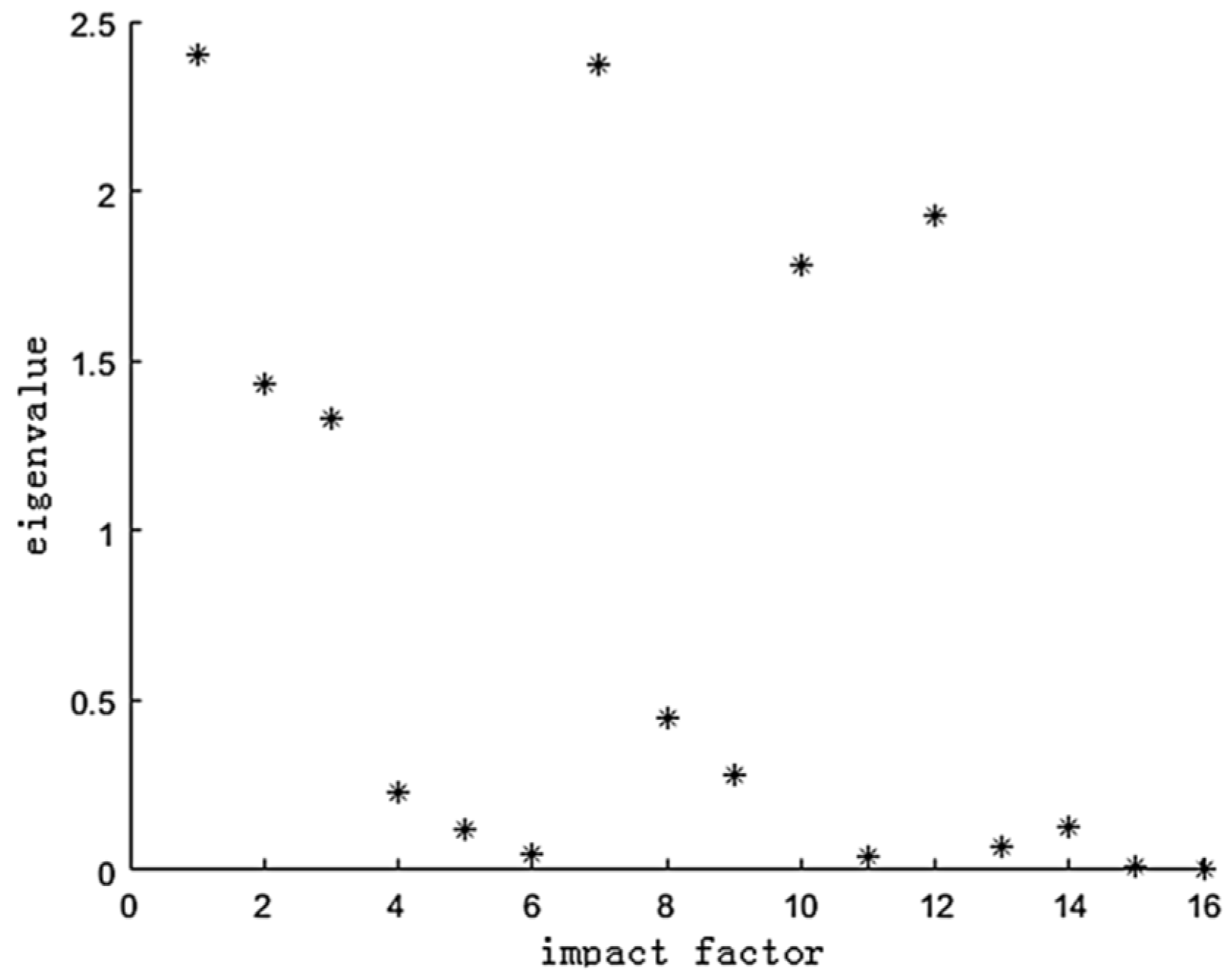
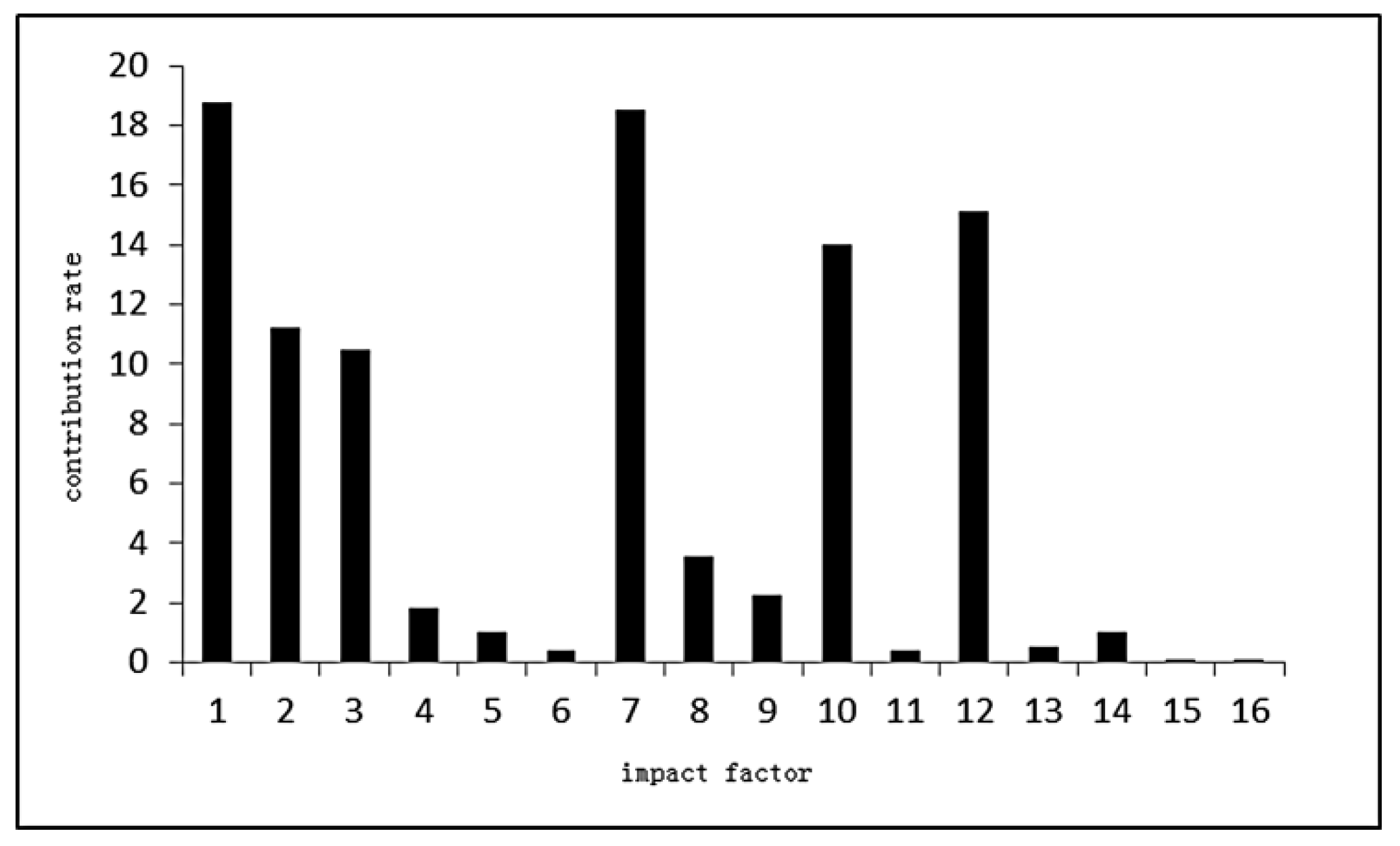
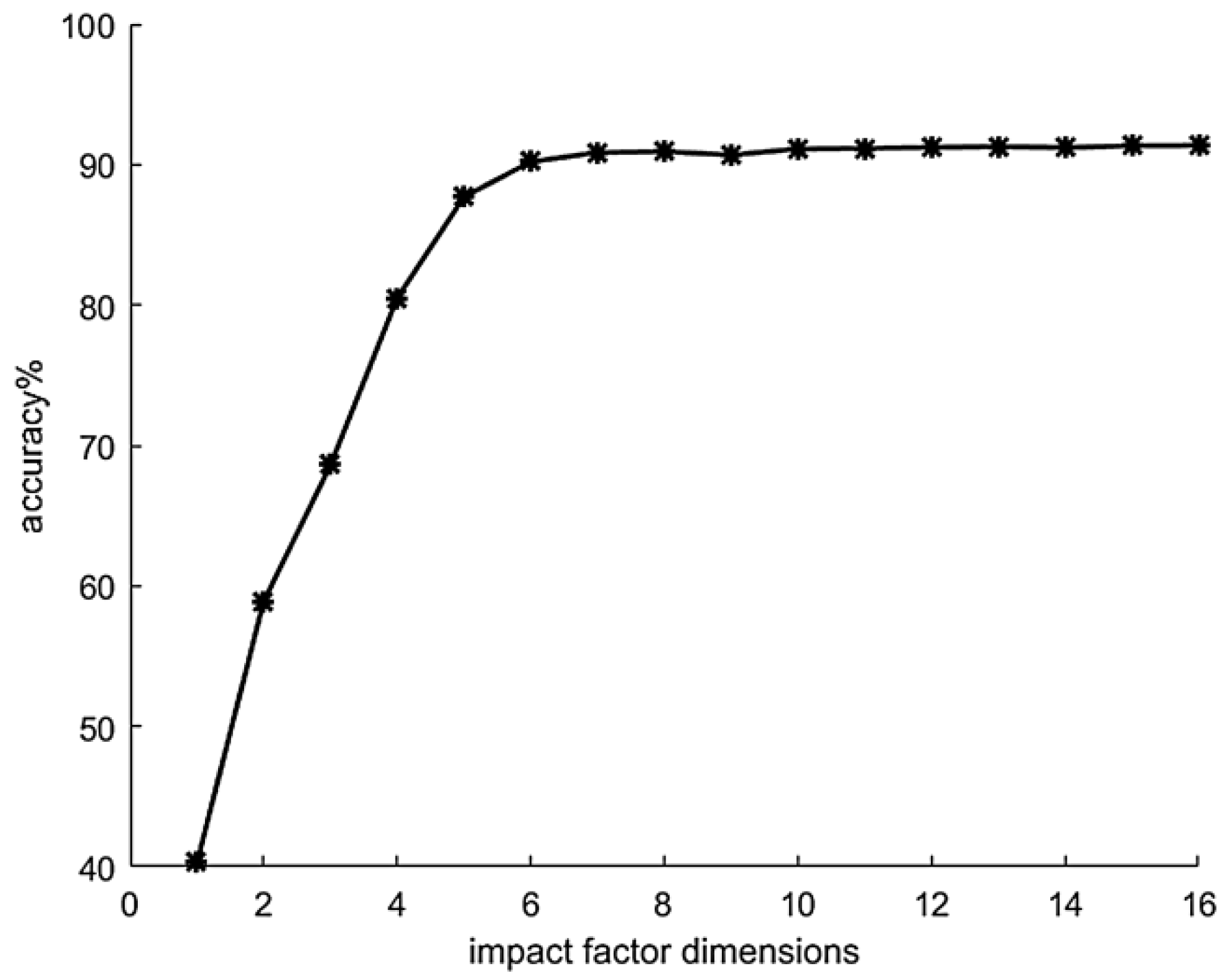
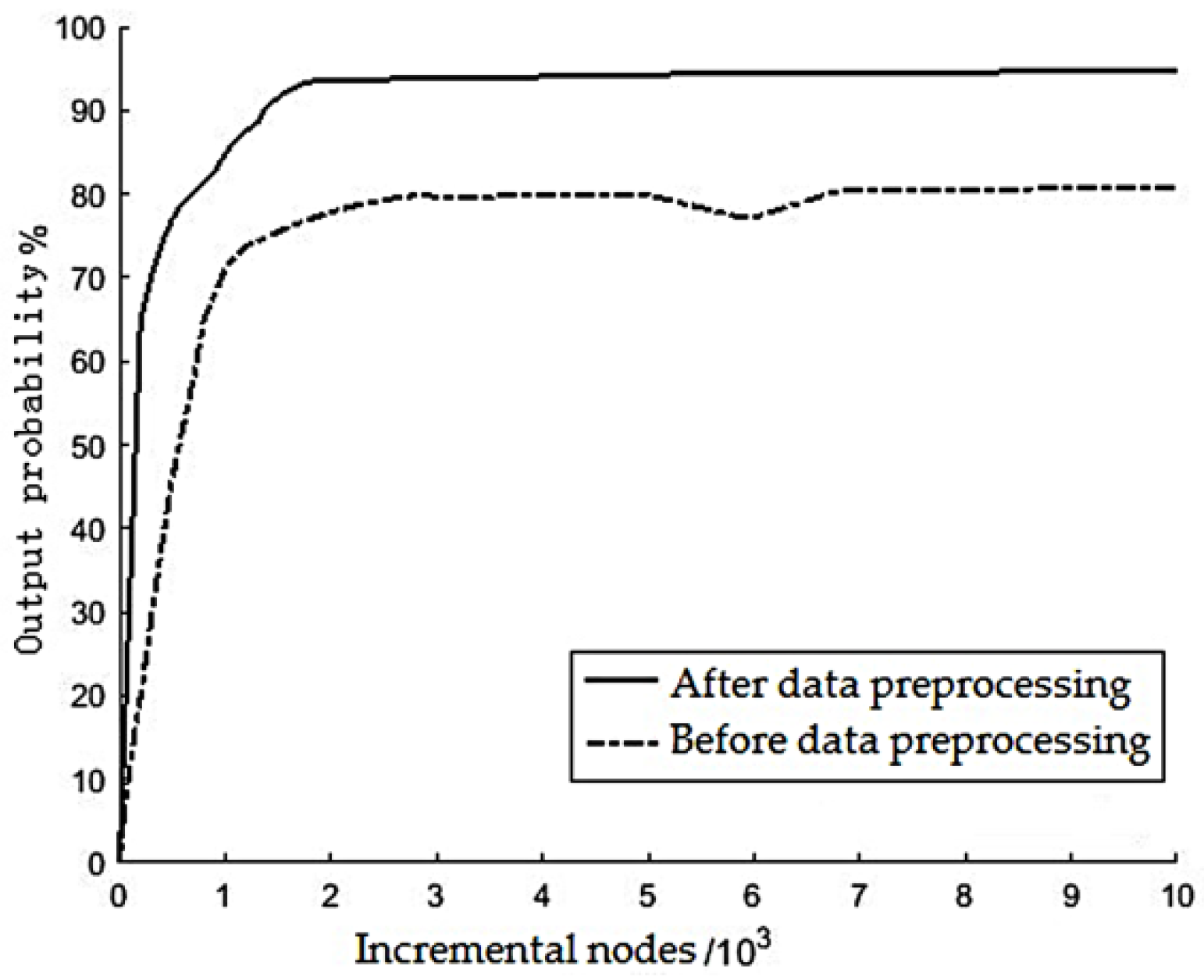
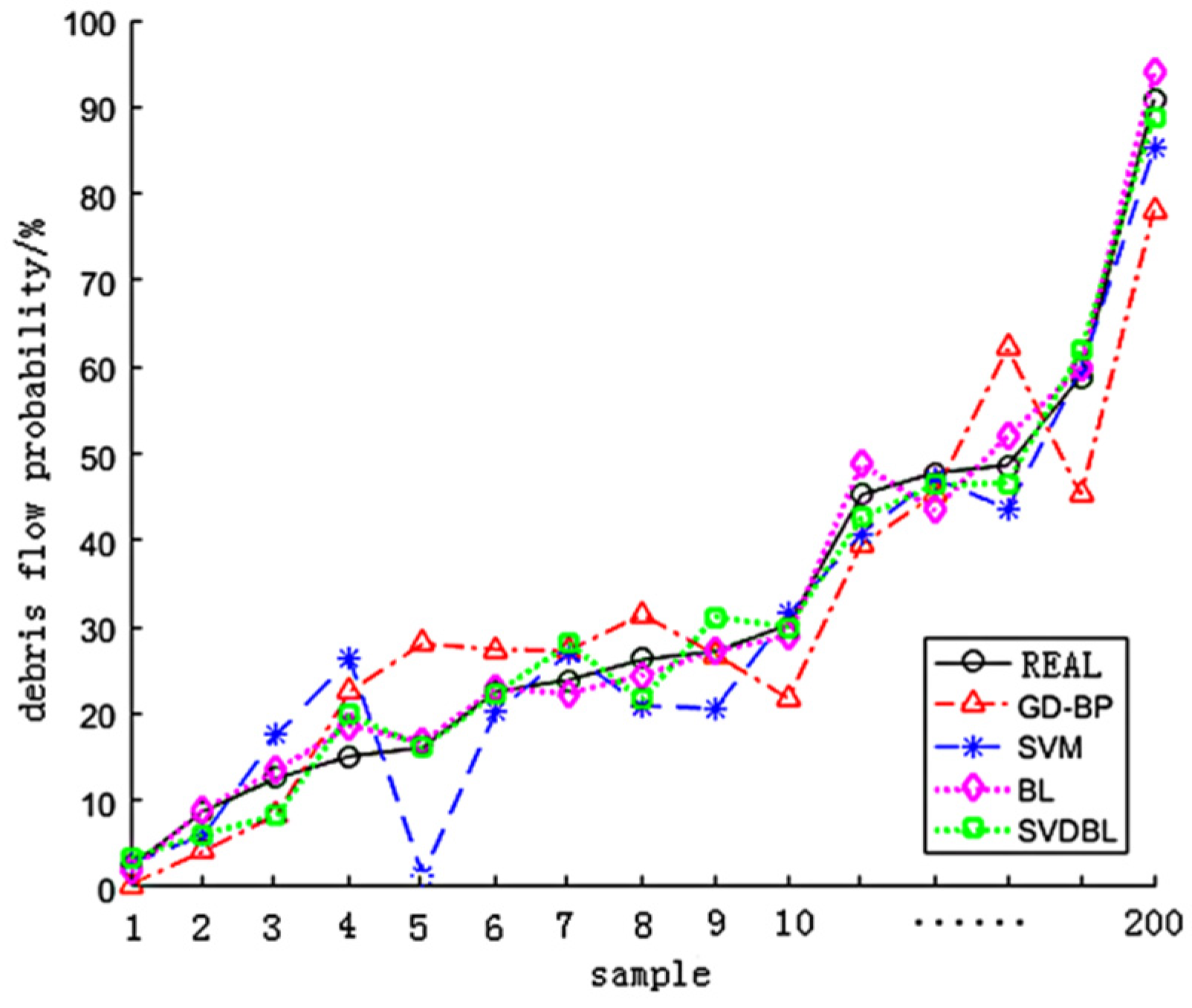

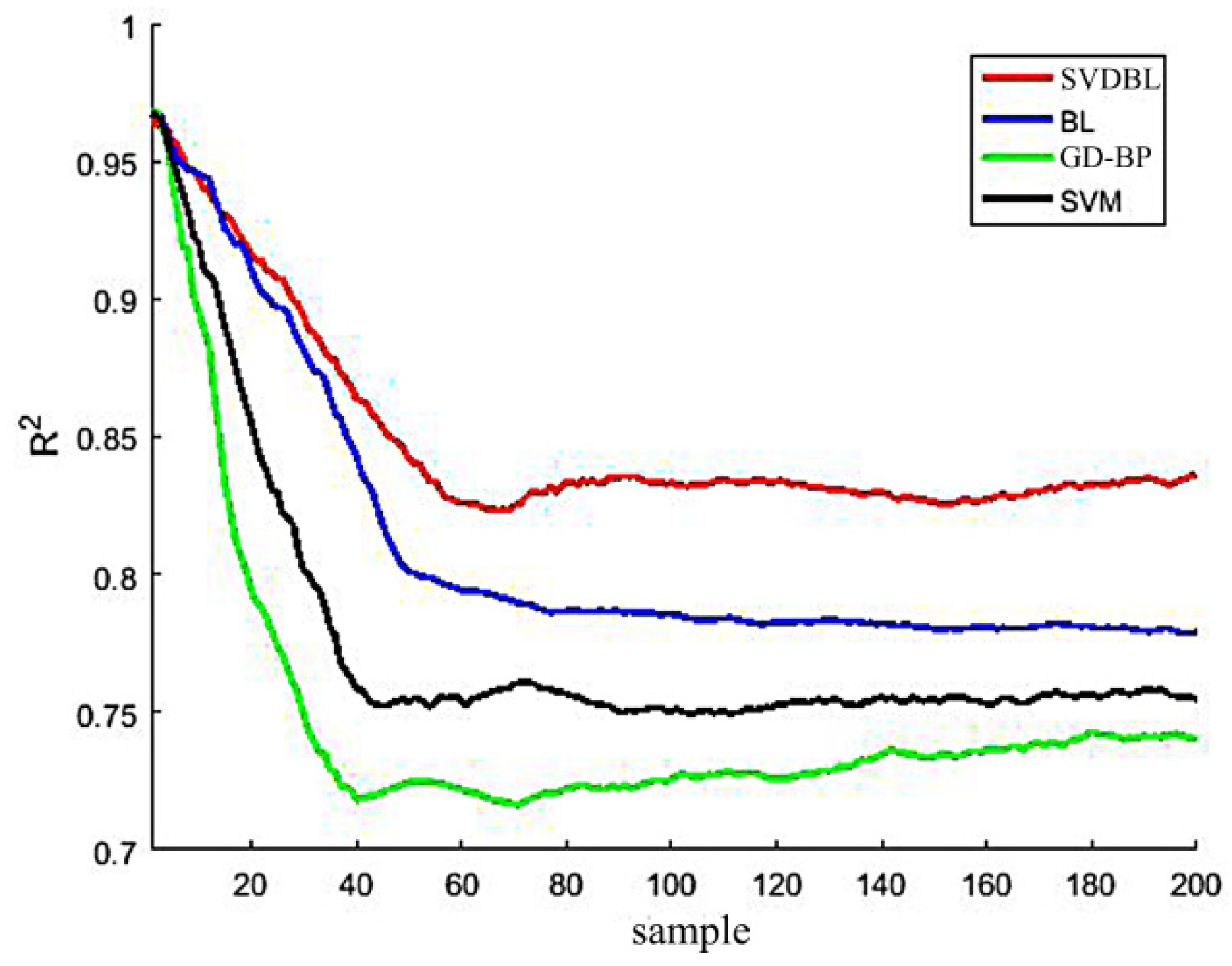
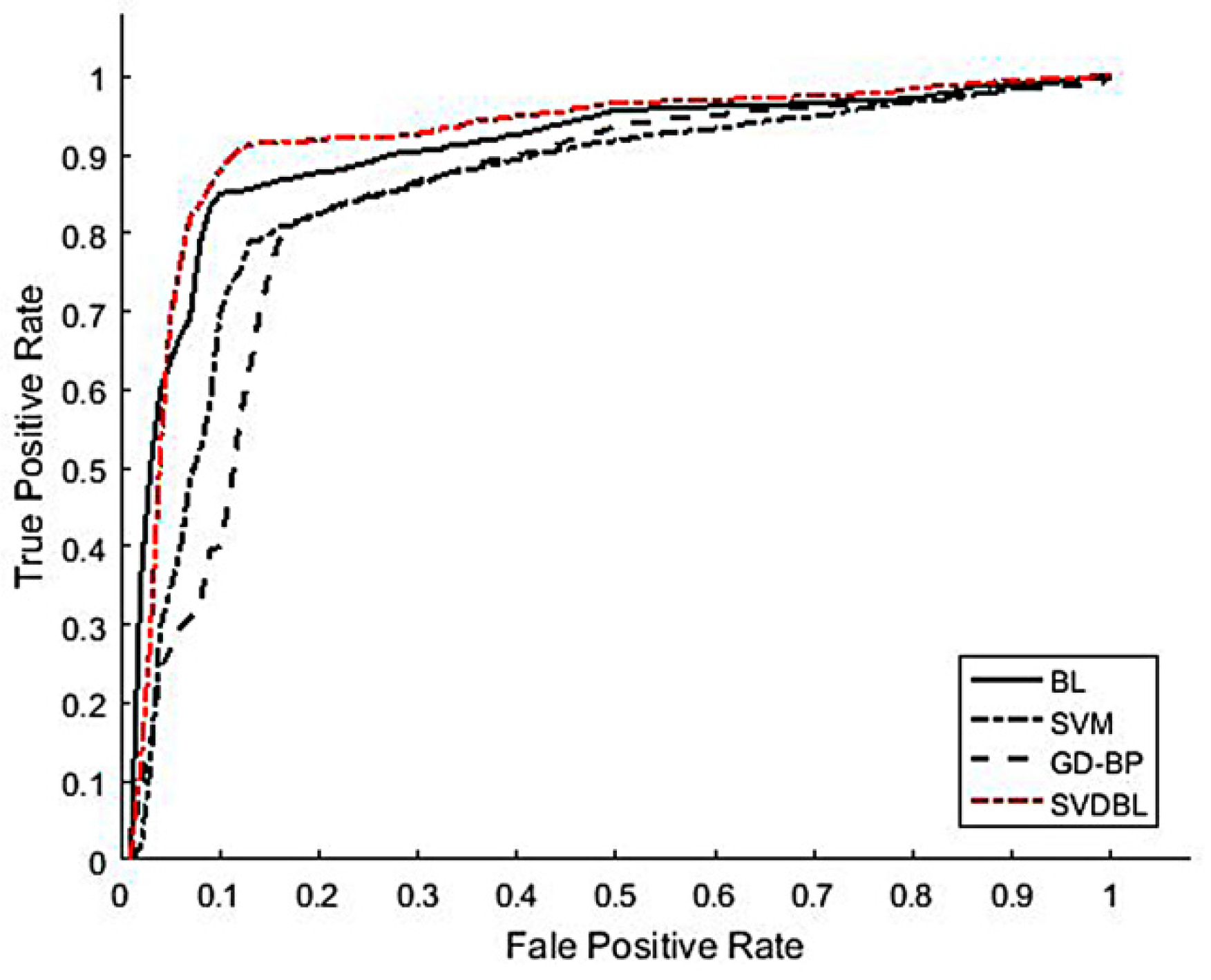
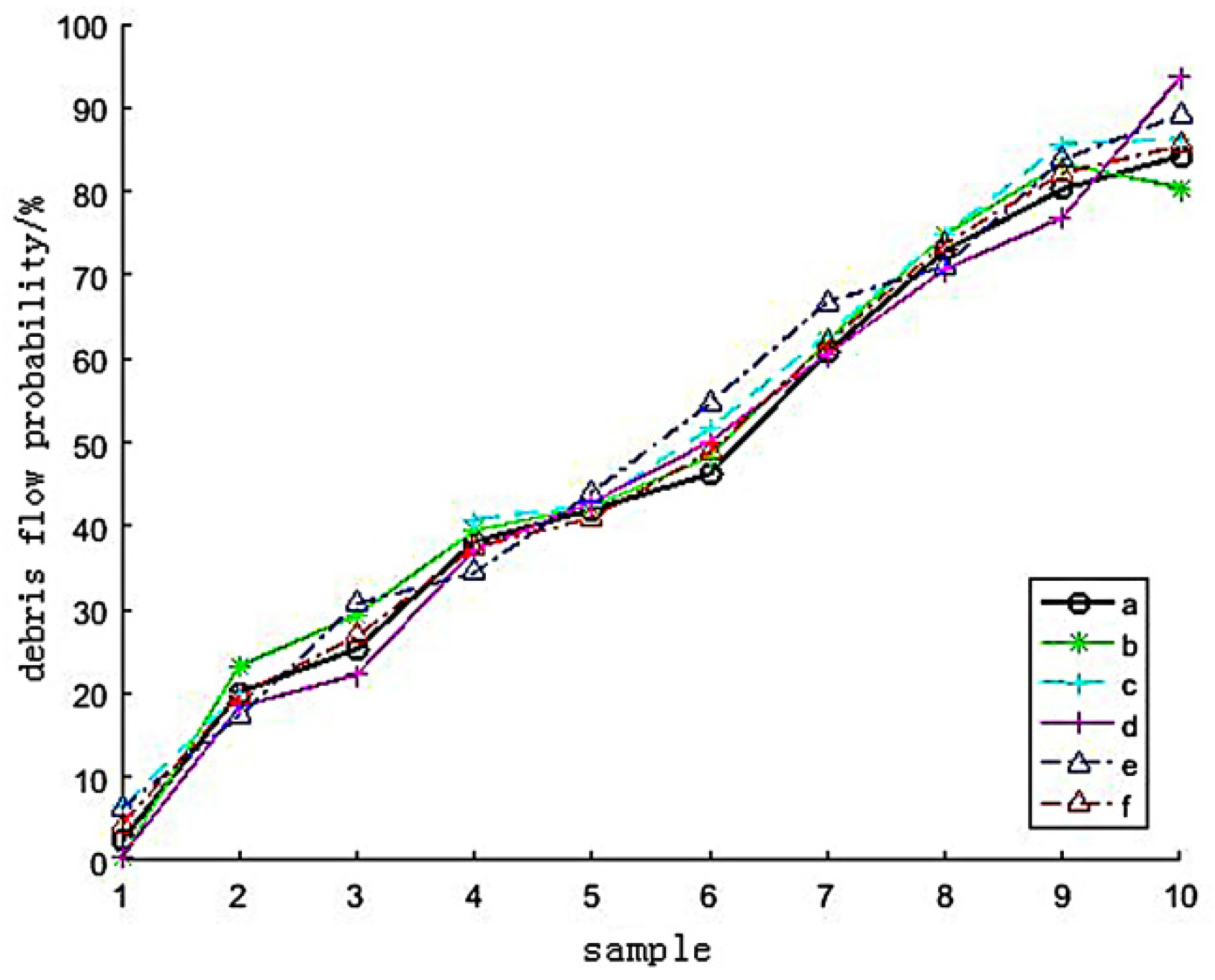
| Number | Influence Factors |
|---|---|
| 1 | Rainfall |
| 2 | Soil moisture content |
| 3 | Pore water pressure |
| 4 | Watershed development degree |
| 5 | Watershed integrity coefficient |
| 6 | Vegetation coverage |
| 7 | Slope gradient |
| 8 | Lithologic |
| 9 | Watershed area |
| 10 | Relative height difference |
| 11 | Erosion and deposition amplitude |
| 12 | Gully bed gradient |
| 13 | Recharge section length ratio |
| 14 | Loose material reserves along the gully |
| 15 | Adverse geologic phenomena |
| 16 | New structure influence |
| Influence Factors | Representation Significance | The Probability of Debris Flow/% | ||||
|---|---|---|---|---|---|---|
| <20 | 20~40 | 40~60 | 60~80 | >80 | ||
| Rainfall/mm | Water source conditions required for debris flow formation, expressed by comprehensive daily rainfall | <20 | 20~50 | 50~75 | 75~100 | >100 |
| Slope gradient/% | The potential energy conditions required for the collection of loose solid matter to quantify the ratio of 25° to 45° area to the basin area | <0.05 | 0.05~0.1 | 0.1~0.15 | 0.15~0.2 | >0.2 |
| Gully bed gradient/‰ | Potential Energy Conditions for Debris Flow Formation | <50 | 50~100 | 100~200 | 200~400 | >400 |
| Relative height difference/m | Terrain Factors of Debris Flow Formation | <20 | 20~40 | 40~60 | 60~80 | >80 |
| Soil moisture content/% | The amount of water in the soil | <8 | 8~16 | 16~24 | 24~32 | >32 |
| Pore water pressure/KPa | The pressure of groundwater in soil or rock, acting between particles or pores. | <10 | 10~25 | 25~40 | 40~60 | >60 |
| Number | Impact Factor | ||
|---|---|---|---|
| Rainfall | Soil Moisture Content | Pore Water Pressure | |
| 1 | 18.32 | 6 | 0.20 |
| 2 | 23.28 | 13 | 0.13 |
| 3 | 17.62 | 20 | 0.48 |
| 4 | 38.74 | 27 | −0.26 |
| … | … | … | … |
| 2000 | 138.62 | 33 | 0.74 |
| Before Data Preprocessing | After Data Preprocessing | ||||
|---|---|---|---|---|---|
| Incremental nodes/Pcs | Accuracy/% | Training time/s | Incremental nodes/Pcs | Accuracy/% | Training time/s |
| 7000 | 80 | 5.8124 | 2000 | 93 | 1.2216 |
| Model | Evaluating Indicators | ||
|---|---|---|---|
| RMSE | MAPE | R2 | |
| GD-BP | 0.3706 | 0.0526 | 0.7826 |
| SVM | 0.3215 | 0.0468 | 0.7583 |
| BL | 0.2541 | 0.0022 | 0.8294 |
| SVDBL | 0.2397 | 0.0212 | 0.8603 |
| Model | GD-BP | SVM | BL | SVDBL |
|---|---|---|---|---|
| Average accuracy/% | 85.5 | 90 | 92.5 | 93 |
| Average training time/s | 23.2906 | 18.1740 | 2.8899 | 1.2216 |
| Warning Level | Possibility of Disaster | Color Identification | Explanation | Probability |
|---|---|---|---|---|
| I | Very low | Green | Only send information to decision-makers | <20% |
| II | Lower | Blue | Push information to decision-makers and related technical personnel | 20%~40% |
| III | Medium | Huang | Recommend preventive measures | 40%~60% |
| IV | Higher | Orange | Take preventive measures | 60%~80% |
| V | Extremely high | Red | Organizing a public emergency response | >80% |
| Model | Average AUC Value/% | Average Training Time/s |
|---|---|---|
| GD-BP | 80.41% | 0.0817 |
| SVM | 85.52% | 0.0049 |
| BL | 90.37% | 0.0022 |
| SVDBL | 93.16% | 0.0010 |
| Model | Results of before Training Sample Expansion | Results of after Training Sample Expansion |
|---|---|---|
| Training Time/s | Training Time/s | |
| GD-BP | 23.2906 | 31.9558 |
| SVM | 18.1740 | 22.9869 |
| BL | 2.8899 | 4.0573 |
| SVDBL | 1.2216 | 1.2299 |
Publisher’s Note: MDPI stays neutral with regard to jurisdictional claims in published maps and institutional affiliations. |
© 2022 by the authors. Licensee MDPI, Basel, Switzerland. This article is an open access article distributed under the terms and conditions of the Creative Commons Attribution (CC BY) license (https://creativecommons.org/licenses/by/4.0/).
Share and Cite
Xu, G.; Yan, X.-E.; Cao, N.; Ma, J.; Xie, G.; Li, L. Debris Flow Prediction Based on the Fast Multiple Principal Component Extraction and Optimized Broad Learning. Water 2022, 14, 3374. https://doi.org/10.3390/w14213374
Xu G, Yan X-E, Cao N, Ma J, Xie G, Li L. Debris Flow Prediction Based on the Fast Multiple Principal Component Extraction and Optimized Broad Learning. Water. 2022; 14(21):3374. https://doi.org/10.3390/w14213374
Chicago/Turabian StyleXu, Genqi, Xin-E Yan, Ning Cao, Jing Ma, Guokun Xie, and Lu Li. 2022. "Debris Flow Prediction Based on the Fast Multiple Principal Component Extraction and Optimized Broad Learning" Water 14, no. 21: 3374. https://doi.org/10.3390/w14213374
APA StyleXu, G., Yan, X.-E., Cao, N., Ma, J., Xie, G., & Li, L. (2022). Debris Flow Prediction Based on the Fast Multiple Principal Component Extraction and Optimized Broad Learning. Water, 14(21), 3374. https://doi.org/10.3390/w14213374






